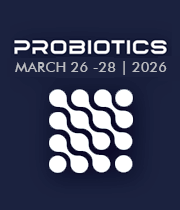Title : Calf-gut multi species probiotic shows enhanced anti-microbial potential against different E. coli isolates from field
Abstract:
Multi strain probiotics are considered to have a wide range of possible advantages due to greater variety of microbes and hence broader efficacy spectrum against gut pathogens. This study explores the comparative assessment of autochthonous probiotic strains individually or in combination for their anti-microbial ability against common enteric pathogens using battery of in vitro tests. Ten autochthonous lactic acid bacteria belonging to Lactobacillus and Pediococcus genus (RM 139, RM 144, RM 146, RM 148, RM 149, RM 150, RM 151, RM 125, RM 119 and RM 122) from calf-gut were assessed for their probiotic attributes.
All the isolates were able to tolerate gastric pH 2, 3 and intestinal pH 7, 8 up to 6 hours of incubation. The isolates flourished very well under different bile salt concentrations (0, 0.3 and 1 %) up to 6 hours of incubation with decrease of only about 2% and 11% for 0.3 and 1 % bile salt, at end of 6h of incubation. The isolates had high Cell surface hydrophobicity, strong (RM 149, RM 125 and RM 119) to moderate biofilm formation. Isolates RM 144 (135.63µl/ml), RM 148(133.14µl/ml) and RM 149(130.56µl/ml) showed the maximum lactic acid production, whereas for other isolates lactic acid production ranged from 86-127µl/ml. All the isolates were positive for presence of bacteriocin gene. The antibiotic susceptibility against 8 antibiotics showed that all the isolates were resistant to vancomycin, oxytetracycline, clindamycin and erythromycin, with variable susceptibility to Ampicillin, Levofloxacin, Cephalolhin, Gentamycin.
E.coli has been reported as primary or secondary infection in every kind of neonatal diarrhoea as bacterial infection.In order to assess the antimicrobial activity against E. coli, all the isolates were initially tested against E. coli ATCC strain and produced zone of inhibition (ZOI) ranging from 13-19 mm with maximum inhibition shown by RM 149, RM 150, RM 125 and RM 119. Based on this, these four isolates with highest ZOI were shortlisted to assess the antimicrobial potential of the selected four isolates in combination. To study the possible antagonism among the shortlisted four isolates, cross streak assay was performed, which showed that there was no antagonism amongst the selected strains. Further, 11 combinations (6 binary, 4 tertiary and 1 quaternary) of the selected isolates were assessed for their anti microbial activity against different E. coli isolates with 7 different serotypes and 5 field strains from neonatal calf diarrhoea samples. Interestingly, it was observed that some combinations showed higher ZOI than individual isolates and other combinations. Combination of RM149+RM150+RM125+RM119 showed the highest inhibition followed by RM149+RM150 and RM149+RM150+RM119 than individual or other probiotic combinations for most of the E. coli strains tested.
It was clear from the study that multi strain probiotics have higher anti microbial activity than the single strains. However, only specific combinations of probiotics can provide high anti microbial activity, and thus should be assessed critically in laboratory before preparation of a multistrain probiotic. In our study, multistrain probiotic having four probiotic cultures showed highest antimicrobial activity against various E. coli strains from calf diarrhoea samples.




